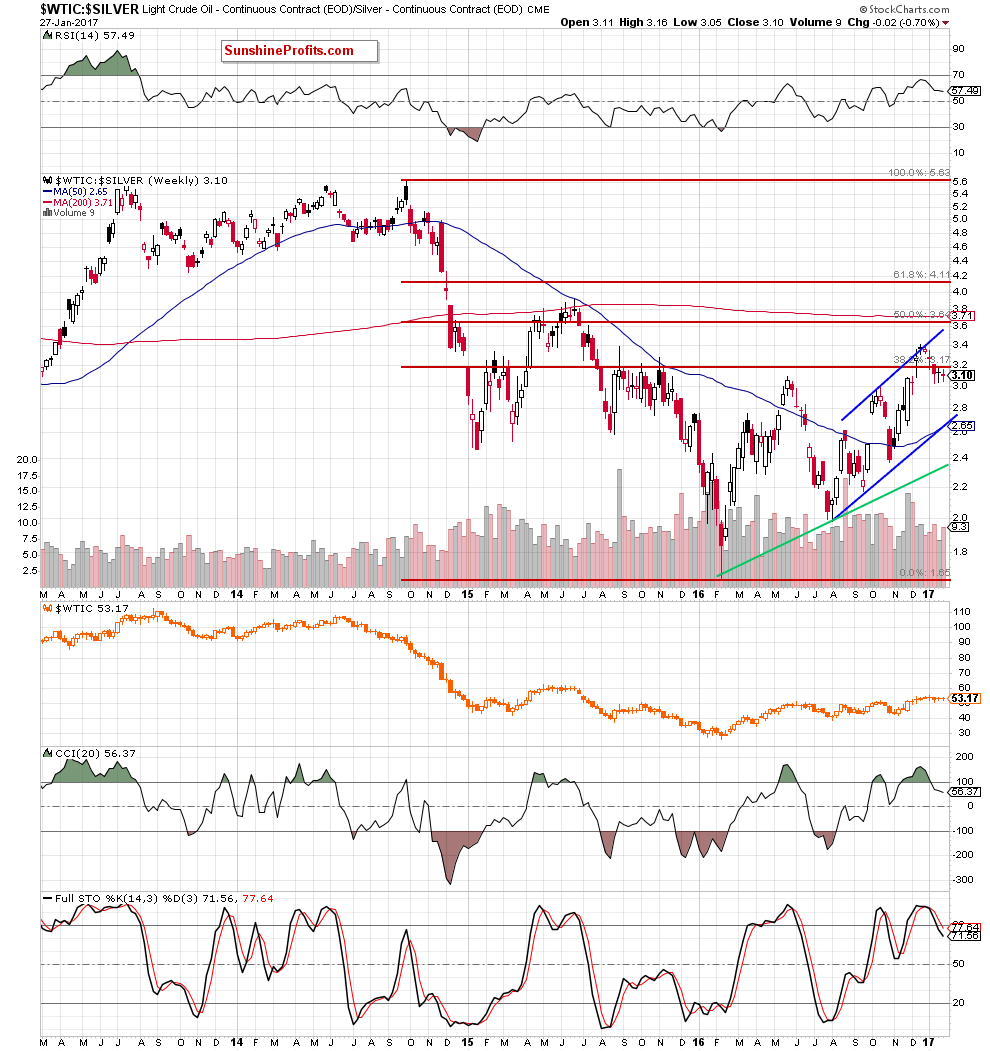Trading position (short-term; our opinion): Short positions (with a stop-loss order at $56.45 and an initial downside target at $45.81) are justified from the risk/reward perspective.
On Friday, crude oil lost 1.13% after the Baker Hughes’ report showed that U.S. drillers added 13 rigs in the previous week. Thanks to this news light crude reversed and declined, invalidating the earlier breakout above the resistance line. What does it mean for the black gold?
Let’s examine the charts below to find out (charts courtesy of http://stockcharts.com).

On the weekly chart, we see that the medium-term situation remains unchanged as crude oil is still trading in a narrow range between the previously-broken long-term red support/resistance line and the red gap, which continues to keep gains in check. Nevertheless, the sell signals generated by the indicators are still in play, supporting oil bears and another attempt to move lower.
Are there any other technical factors that could encourage the sellers to act? Let’s examine the daily chart and find out.

The first thing that catches the eye on the daily chart is an invalidation of the breakout above the orange declining line based on the previous highs. This is a negative development, which suggests further deterioration. This scenario is also reinforced by the fact that light crude is still trading under the previous highs, which means that the double top formation and the potential head and shoulders pattern are still in place, suggesting another attempt to move lower in the coming days.
If this is the case and we see a decline from here, crude oil will re-test the green support zone and the long-term red line (seen on the weekly chart) once again in a very near future. If this area is broken, the next downside target will be the red support line based on the previous lows (the neck line of the potential head and shoulders formation).
Before we summarize today’s alert, we would like to draw your attention to the current situation in the oil-to-silver ratio.

On the weekly chart, we see that the ratio closed another week under the previously-broken 38.2% Fibonacci, which together with the sell signals generated by the indicators suggest further deterioration (in the ratio and also in crude oil) in the coming weeks.
Summing up, short positions continue to be justified as the double top formation and the potential head and shoulders pattern remain in place, suggesting another attempt to move lower in the coming days.
Very short-term outlook: bearish
Short-term outlook: bearish
MT outlook: bearish
LT outlook: mixed
Trading position (short-term; our opinion): Short positions (with a stop-loss order at $56.45 and an initial downside target at $45.81) are justified from the risk/reward perspective. We will keep you – our subscribers – informed should anything change.
We will keep you – our subscribers – informed should anything change.
As a reminder – “initial target price” means exactly that – an “initial” one, it’s not a price level at which we suggest closing positions. If this becomes the case (like it did in the previous trade) we will refer to these levels as levels of exit orders (exactly as we’ve done previously). Stop-loss levels, however, are naturally not “initial”, but something that, in our opinion, might be entered as an order.
Since it is impossible to synchronize target prices and stop-loss levels for all the ETFs and ETNs with the main market that we provide this level for (crude oil), the stop-loss level and target price for popular ETN and ETF (among other: USO, DWTI, UWTI) are provided as supplementary, and not as “final”. This means that if a stop-loss or a target level is reached for any of the “additional instruments” (DWTI for instance), but not for the “main instrument” (crude oil in this case), we will view positions in both crude oil and DWTI as still open and the stop-loss for DWTI would have to be moved lower. On the other hand, if crude oil moves to a stop-loss level but DWTI doesn’t, then we will view both positions (in crude oil and DWTI) as closed. In other words, since it’s not possible to be 100% certain that each related instrument moves to a given level when the underlying instrument does, we can’t provide levels that would be binding. The levels that we do provide are our best estimate of the levels that will correspond to the levels in the underlying assets, but it will be the underlying assets that one will need to focus on regarding the sings pointing to closing a given position or keeping it open. We might adjust the levels in the “additional instruments” without adjusting the levels in the “main instruments”, which will simply mean that we have improved our estimation of these levels, not that we changed our outlook on the markets.
Thank you.
Nadia Simmons
Forex & Oil Trading Strategist
Przemyslaw Radomski, CFA
Founder, Editor-in-chief, Gold & Silver Fund Manager
Gold & Silver Trading Alerts
Forex Trading Alerts
Oil Investment Updates
Oil Trading Alerts



